Your baby has just been born. Would you let someone draw their blood and remove 30% of their blood volume?
I became a midwife before I birthed my own babies. People often ask me how my practice changed after I became a mother and gave birth. All midwives advocate for the needs of babies, but giving birth to my own baby afforded me a more direct and visceral connection to the baby’s birth experience than I had previously known (among other things!). I am more deeply attuned to how both mother and baby experience labor, birth and the hours after birth — physiologically and emotionally; From their passage through the pelvis (or abdomen) to their first moments touching, hearing and smelling each other, it is a sacred and biologically unique time.
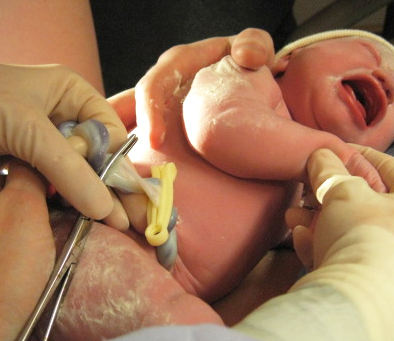
Here you can clearly see the red, oxygen rich blood still in the cord that is about to be severed. This baby did not receive that cord blood that nature intended her to have.
Harmful cord clamping practices are one of the first interventions experienced by most babies born in the US. (Sometimes they are also needlessly bulb-suctioned or removed from their mother). Cutting the umbilical cord within seconds of the birth, also known as premature or early cord clamping, is a routine practice of hospital births attended by physicians. It is another intervention that has become so second-nature to physicians, and has gone largely unchallenged in the delivery room.
Dr. Nicholas Fogelson is a minority advocate for “delayed” or normal cord clamping within the medical community . While he aptly draws a parallel between premature cord clamping and blood-letting in his latest video series, he is candid about just how far he has come in his practice:
For the majority of my career, I routinely clamped and cut the umbilical cord as soon as it was reasonable. Occasionally a patient would want me to wait to clamp and cut for some arbitrary amount of time, and I would wait, but in my mind this was just humoring the patient and keeping good relations. After all, I had seen all my attendings and upper level residents clamp and cut right away, so it must be the right thing, right?…….
During pregnancy, the baby’s blood circulates in a constant loop in and out of her body. It flows through the body, back into the cord to the placenta, then back through the cord into baby’s body. This pattern of circulation continues until shortly after the birth when the placenta separates from the inside of the uterus. By the time the placenta separates, virtually all the oxygen-rich blood in the placenta and cord (up to 40% of the baby’s total blood volume) has made its way back into the baby.
Why do physicians cord the cut so soon after birth? Most believe that babies if babies receive their full blood volume from the placenta they will have too many red blood cells (polycythemia) and become jaundice. They aim to prevent this by clamping and cutting the cord immediately after birth which stops the flow of blood from the placenta into the baby.
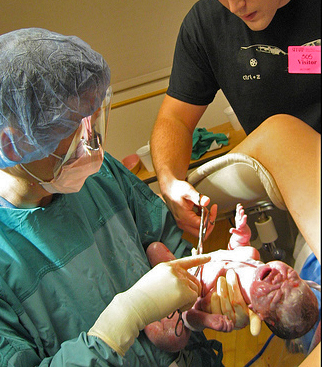
In hospital births, physicians typically clamp and cut the cord moments after birth, and often before giving the baby to the mother.
In premature cord clamping we have an intervention that has become almost universally embedded into hospital birth on account of convenience and a desire to avoid jaundice – the only trade-off is a loss of up to 40% of baby’s blood!? Despite popular medical opinion, research favors delayed cord clamping for both preterm and term babies and has not found a significant association with either polycythemia requiring treatment or jaundice requiring treatment.
Two meta-analysis addressed the subject in the last five years — the JAMA and Cochrane reviews. While the Cochrane review did report a small increase in jaundice requiring phototherapy among late cord-clamped babies (5% as opposed to 3% in the early clamping group), these results were based on one particular study that has been criticized by experts and physicians for a number of good reasons. It is an unpublished PhD paper written by one of the review authors, and since the study was not published or peer reviewed its design raises a number of questions: we don’t know whether the physicians referring to treatment were blinded, whether confounding factors were accounted for, or what threshold for treatment was used 12 years ago in Australia when the study was undertaken. The JAMA review found no increase in jaundice requiring phototherapy.
I’ve seen a good number of jaundice babies in my years attending homebirths, so for argument’s sake let’s say babies who have delayed cord clamping do develop more jaundice. Is really worth significantly reducing their blood volume in order to reduce their odds of becoming jaundice? Jaundice is “physiologic,” meaning normal. Many healthy babies will become jaundice regardless of when their cord was clamped. The vast majority of newborns with jaundice are normal and healthy and do not require medical intervention. Depriving infants their full blood volume is not a reasonable response to something as common as jaundice.
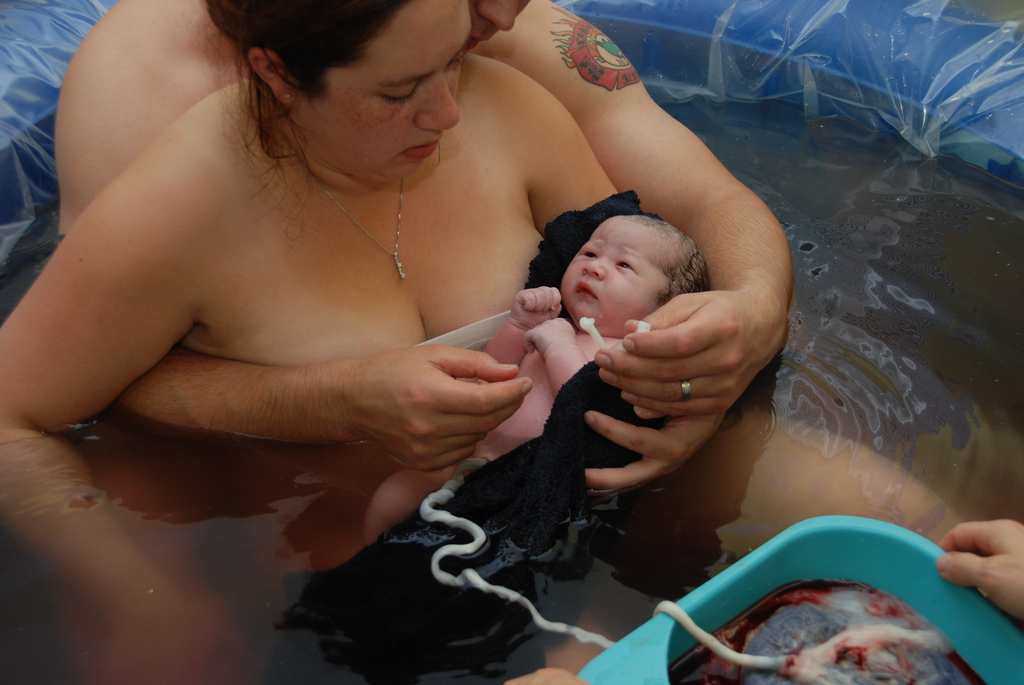
The placenta has been born, the cord is flaccid and pale, and the parents are ready to clamp the umbilical cord. The baby has received her full blood volume.
Why should we leave the cords alone? It would be highly dangerous and to remove one-third of the baby’s blood from their body before they were born, yet doing it immediately after birth has become the norm. Reknown physician and author of Zoonomia, Erasmus Darwin, recognized the danger in premature cord clamping in the 1800s:
Another thing very injurious to the child, is the tying and cutting of the navel string too soon; which should always be left till the child has not only repeatedly breathed but till all pulsation in the cord ceases. As otherwise the child is much weaker than it ought to be, a portion of the blood being left in the placenta, which ought to have been in the child. (Zoonomia)
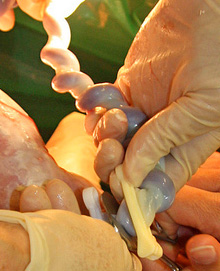
A little more physiology can help us understand why that blood is vital: Immediately after birth, babies transition from breathing amniotic fluid to breathing air. This change requires the heart to pump far more blood to the lungs than it had before. All the blood from the placenta and cord is needed in this process. The blood from the placenta also sends more oxygen around the body. This transition process can take longer and be more difficult if the cord is cut early, preventing the baby from receiving her or his full blood volume. In these cases babies often require supplemental oxygen — oxygen that would have been supplied by the umbilical cord. We know now too that keeping the cord intact during resuscitation actually helps babies who are having trouble transitioning and breathing. (Check out this new innovative mobile warmer unit from the UK that allows babies to be resuscitated with their cords intact).
Preterm babies also benefit greatly from delayed or physiologic cord clamping. The benefits of keeping their full blood volume extend beyond the newborn period into infancy as well. Babies have greater hemoglobin (iron) levels in the months after birth and benefit from the stem cells, antibodies and other life-sustaining components of their blood.
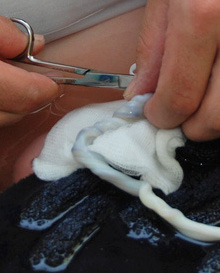
This cord has finished pumping blood from the placenta to the baby. You can see only a residual amount of blood through the cord. It is pale, flacid, thin and elongated.
This cord was still pumping blood from the placenta to the baby when it was clamped. You can see blood in the vessels; the blood pressure gives the cord its shape.
How do you know when the cord is ready to be cut? If the cord is still fat, taught, and spiraling it’s not time to cut yet. If blood spurts out when it was cut, it was cut prematurely. In most cases it is just as easy to wait until the placenta is born to cut the cord. At homebirths, midwives typically wait to clamp and cut the cord until it has stopped pulsing or the placenta has been born. Waiting for the placenta also ensures that mothers and babies remain undisturbed in those precious and finite moments after birth.
I encourage women whose care providers insist on premature cord clamping to familiarize themselves with the subject and ask their physicians if they are aware of the body of research supporting delayed cord clamping. You are your baby’s best advocate!
